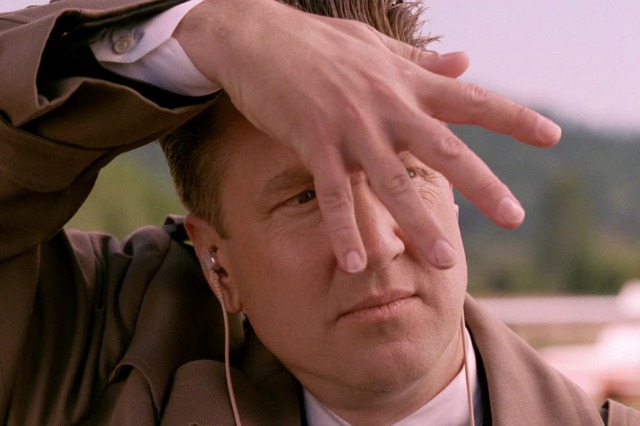10 Reasons 'Twin Peaks: Fire Walk With Me' Is Bloody Brilliant
By Joel Wicklund in Arts & Entertainment on Jun 23, 2016 6:27PM

David Lynch as Agent Gordon Cole in "Twin Peaks: Fire Walk with Me." (Photo: ©1992 New Line Cinema Corp.)
David Lynch's upcoming Twin Peaks revival for Showtime may be the most anticipated TV event of next year. But let's not forget that in 1992, the Twin Peaks saga itself ended with a whimper, not a bang, following the lackluster reception of its big-screen incarnation Twin Peaks: Fire Walk with Me. The movie deserved more credit than it got, though. With midnight showings at the Music Box this weekend, it's a perfect time to dig into its underrated greatness.
When it debuted on ABC in 1990, Twin Peaks was the darkest, strangest thing to ever air on network television. The show's first eight episodes were greeted with critical acclaim and high ratings. But in the second season, the show answered the much-hyped question: who killed Laura Palmer? After that, the show's plotlines became wildly metaphysical. Ratings dropped, and at the end of its second season, ABC cancelled the show, leaving many story threads unresolved.
Then, in 1992, Lynch delivered Twin Peaks: Fire Walk with Me—which didn't resolve any of the show's lingering questions. (Lynch is, after all, the man who made Eraserhead.) Instead, the movie was a prequel, charting the final days of Laura Palmer. And after an opening half-hour that was fairly close to the narrative style of the show, all conventions were thrown to the wolves. It was a truly experimental film and a box office flop. It was even booed at the Cannes Film Festival.
We early defenders of the film have seen the tide turn in the more than 20 years since the film came out, though. Fire Walk with Me now gets some respect, though not enough. Warts and all (and it does have warts, including the infamous turkey dialogue), it is a fascinating, harrowing work. Here are ten reasons it's brilliant.
SPOILER ALERT: You may want to skip numbers 1, 7 and 8 if you have not seen the movie or the TV series.
1) It's the most traumatic campfire story ever told.
Most horror stories are rooted in some real life trauma, and the climax of the movie shows that in terrifying fashion. With flashlights dancing across the faces of killer and potential victims, the scene suggests someone shining a light in his face on a dark night to frighten the children with a scary story. But this time, it's not just a story.
2) The Lynch signature is evident behind the camera and in front it.
Not only are Lynch's creative fingerprints all over the movie, as director, writer, sound designer and soundtrack contributor, but he gets significant screen time as hard-of-hearing FBI bureau chief Gordon Cole. And don't you think the creepy little boy in the suit bears more than passing resemblance to the director?
3) Hap's Diner. Enough said.
4) It confronts the tragedy under the nightmare.
Twin Peaks was an unpredictable mix of over-the-top melodrama, absurdist comedy, horror and pure surrealism. But Lynch's portrait of the gloom surrounding lives taken by violence was always sincere. He kicks the despair up several notches in the film, perhaps most heartbreakingly when FBI agents examine the body of the first victim of Laura Palmer's killer. As close-ups of her dead eyes and open mouth are intercut, Agent Desmond (Chris Isaak) says solemnly, "No one came to claim the body. No known next of kin."
5) It's a work of sonic genius.
Lynch is a great visual artist, but from his earliest short films he has been equally adventurous with the sound elements of his work. Backwards masking on sound effects, sudden bursts of noise and eerie drops into total silence are as vital to the film's effectiveness as Angelo Badalamenti's evocative score.
6) David Bowie has a cameo.
7) Ray Wise. Oh my god...Ray Wise!
It's criminal that Wise was never even nominated for an Emmy for his performance as Laura's father Leland on the original series, but he takes the role to even greater heights in this film. Within seconds he can go from a child's nightmare vision of a madman to a crying, grieving father, horrified by his own predatory actions. He is the MVP of the Twin Peaks ensemble.
8) It exposes the beast within.
Killer Bob is the most obvious symbol, but Fire Walk with Me is all about suppressed savagery. It's as if Lynch was trying to exorcise our most appalling collective inner demons and there are even angels on hand to help out with that. But if you really want to go down a rabbit hole of man/beast mystery, check out the monkey in this clip. Is it whispering, "Judy?" Is that the same Judy Bowie's bizarre rogue agent mentions in the clip above? And why doesn't he want to talk about her?
9) Without it, we might not have Mulholland Drive.
Mulholland Drive (2001) is one of Lynch's most celebrated films. Watch Fire Walk with Me and you'll notice several parallels between the two films, from the good-girl-gone-bad duality of Sheryl Lee's Laura Palmer and Naomi Watts' Betty/Diane to the alarming "earth monsters" (the filthy trailer park woman in Fire Walk with Me; that thing behind the diner in Mulholland Drive). The links make sense, as Mulholland Drive reportedly began as an idea for a Twin Peaks movie.
10) Harry Dean Stanton sums up the whole bewildering Twin Peaks experience incredibly well.
Twin Peaks: Fire Walk with Me plays midnight shows at the Music Box Theatre this Friday and Saturday (June 24 & 25).